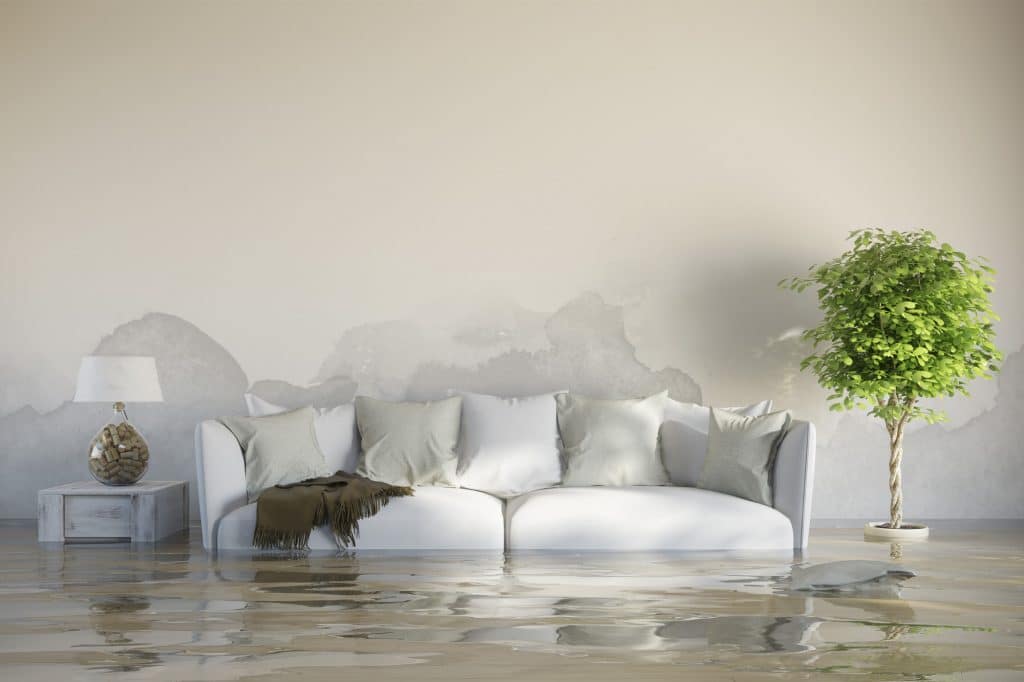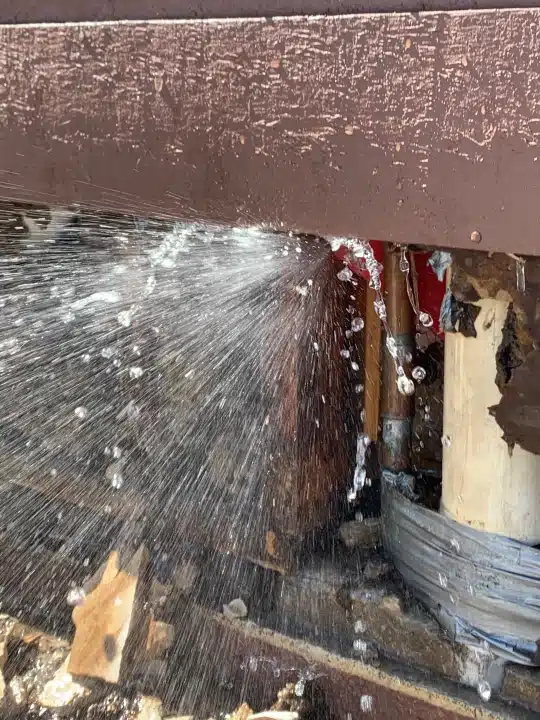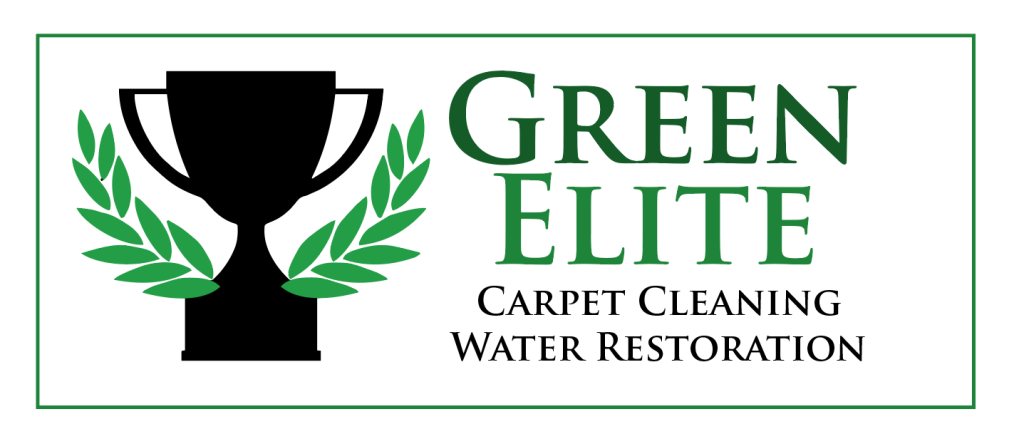OUR SERVICES
WATER DAMAGE RESTORATION
When water enters a home or business and causes damage, it’s important to begin the process of water damage restoration as soon as possible. There are Many factors that go into Water Damage Restoration which will be explained in detail in this article.
The Process Of Water Damage Restoration Can Be broken Down Into Three Stages.
Stage 1
Removing the standing water is the first stage in the process of water damage restoration. Immediately after a flood, homeowners should take steps to remove as much of the standing water as possible. This will make it easier for the process of water damage restoration to be successful and more efficient later on. There are several ways to remove standing water, including using buckets or mops, mopping with towels or rags, using large commercial fans and dehumidifiers, opening windows to allow air circulation that will pull moisture out through evaporation or simply throwing towels on top of puddles so they absorb the excess liquid on their own. However it’s done, the process of water damage restoration is easier if standing water is removed as soon as possible.
Stage 2
Once all the standing water has been removed, homeowners need to take steps to remove any items that were damaged by the water. This process may require professional assistance from a fire and water restoration service provider since it involves getting rid of certain types of materials that pose health risks to humans, such as insulation or drywall that have been saturated with stagnant water for more than 48 hours. There are several ways a home’s contents can be disposed of after a water damage. Some companies offer junk removal services while others specialize in debris disposal or complete demolition and rebuilds. When choosing a company for this process, it’s important to choose one that can deal with removing potentially hazardous material.
Stage 3
Finally, once all the water damage has been eliminated and any contaminated items have been removed from the home. This process should be handled by a professional restoration service provider since there are many techniques that must be used in order for it to be successful. They often use dehumidifiers and disinfectants as part of their process as well as ozone generators. When the water damage is completed you can take steps such as installing additional ventilation, selecting floors that can withstand moisture, using paints that are created to be mold-resistant and drywall made with materials that can resist water damage.
What Are The Main Causes Of Water Damage?
Water damage causes can be either natural or man-made. These causes include things like storms, burst pipes, and leaks from appliances. The causes of water damage can also be a result of a miscellaneous mishap–such as a toilet overflows due to poor flushing habits.
Natural causes of Water Damage
The first type of causes is the natural causes which mostly come from the surroundings of the house such as hurricanes or tornadoes or excessive rainfall, all cases can result in moisture seeping into your home’s foundation.


Man-made causes of Water Damage
The causes that are man-made include causes that come from different appliances in your home, such as dishwashers or washing machines. When these appliances overflow, the causes can be devastating to homes because not only does it damage the appliance but also causes widespread moisture in flooring, walls, ceilings and attics making your whole house suffer from mold infestation. The other causes are usually the result of faulty plumbing installations which often occur with poorly done waterproofing jobs or improperly attached supply lines.
Burst pipes are also another common cause of water damage, burst pipes tend to be major causes when the weather starts getting colder, burst pipes can cause anything from a small leak to extensive damage and this is because it causes water damage in your home that often goes unnoticed until there is too much moisture and mold.
Toilet overflows are usually an indication of poor flushing habits but they can also be indications of bigger problems within the plumbing system such as collapsed supply lines or corroded valves.
Is Water Damage Covered By My Insurance Company?
The types of water related damages that are covered by a water damage insurance company depends on your policy. In most cases a water related incident, such as a burst pipe or a water heater malfunction will be covered under your homeowners insurance. If water has been allowed to sit for too long it may even qualify for coverage if the home owner, or someone who was responsible for upkeep of the property neglected proper maintenance and preventative measures like draining water from appliances and letting dehumidifiers run after floods. The problem is that water can do tremendous unnoticed damage over time, and not everyone knows how to notice signs of water problems before they become catastrophic damages.
The water damage that is the most difficult to understand is water damage caused by water that has not come into contact with anything else. This water damage comes from hidden sources, like water seeping behind walls or in floors and ceilings. This water related damage can go by unnoticed until there is heavy water damage, which might be too late for your insurance company to cover. For this reason it’s important to take proactive measures in protecting your home against unseen water problems, even if you don’t think they are an issue right now.
One way you can protect your home against water problems is with a moisture sensor. Moisture sensors will notify you when humidity levels get high enough in specific areas of your house where water mold, mildew, and other water damage problems could become a threat. The best way to find out if water damage is cover in your policy is to check with your insurance company.

How To Prevent A Water Damage?
Did you know that every 40 seconds, a water damage occurs in the United States? With such frequent and potentially devastating occurrences, it’s crucial to take preventative measures that will prevent damage from occurring. Water damage is an unfortunate event that can happen anywhere at any time. While preventative steps are crucial, it’s important to be aware of the warning signs for water damage so you know how to prevent a water damage before it occurs.
Here are five preventative tips that will help ease your mind.
Keep your gutters clean of debris. If allowed to accumulate, leaves and other natural elements prevent proper drainage of rain water on your property which can lead to a massive amount of water penetrating a weak section in your roof, resulting in a leak!
Check the exterior areas for cracking paint or peeling siding. These common damages can be caused by moisture build up behind deteriorating exterior walls which could lead to water damage if not treated immediately.
Inspect the basement for cracks in the foundation, leaks through cement joints and leaking pipes. These are just some telltale signs that preventative measures should be taken before any damage is done.
Ensure toilet tanks have been sealed with plumber’s tape when installing new toilets. If left unsealed, over time water will begin to seep through the flapper valve and into the bowl resulting in unsanitary conditions that can lead to preventable damage.
Keep your appliances up to date by having them serviced once a year. Older appliances are more likely to malfunction and leak causing preventable damage.
What are the Hazards of Water Damage?
Water damage has many negative effects on your home. The most obvious is the structural damage that water can cause to your building. However, there are any other dangers in ignoring water damage that you may not have thought of before.
There are many different types of water that can cause significant problems to your home and it’s inhabitants. The foremost danger is biological contaminants that naturally occur in flood waters such as sewage, viruses, and bacteria. The flood water poses a threat for any open wounds or cuts you may have while wading through the flood waters or while cleaning up afterwords. The flood water can also seep into the floorboards and walls causing fungus growths such as mold. The indoor air quality could become very dangerous should mold spores enter your respiratory system .
The other danger is electrocution due to faulty wiring. The last threats are chemical contaminant which you may not be able to see but pose the most risk of long term sickness. The water damage can also cause serious external damage that can be seen very easily such as warping wood floors, rotting walls, and peeling paint. The water damage could also be causing unseen problems within your walls such as rusting metals and rotting wood. The hazards of water damage can cause many issues that could ultimately destroy your home or create a liability issue. The danger of hidden dangers could hinder any future sale you plan on making because the potential buyer may see these things to be too great of an issue to pay for.
How To Find A Great Water Damage Restoration Company
When you find yourself faced with water damage, finding a top-notch restoration company can seem like an intimidating task. Here are some steps to take when searching for the ideal water damage restoration company before disaster strikes
1) Make Yourself Aware Of The Different Types Of Restoration Companies And What They Specialize In
There are different types of water damage companies specializing in different areas. Some companies do not specialize in any area of restoration, instead they offer general services which cover all varieties of disasters. Other companies might be limited to only one type of service; roofing, mold removal or carpet cleaning for example. By educating yourself on the various types of services offered by these companies you will find it easier to pinpoint the right fit for your situation .
2) Ask The Right Questions
When you find a few companies that specialize in water damage, call them up and ask about their services. Make sure to find out what type of equipment they use, if the staff is certified experts in restoration, if the company has insurance coverage, and an emergency line available 24/7.
3) Find Out About Their Previous Clients And How Well They Were Satisfied With The Service
If it is possible find out how well past clients were satisfied with the service provided by any prospective companies. You can usually find this information through online review sites such as Google, Nextdoor, Facebook and Yelp or word of mouth from other people have used these services before.
4) Find Out About Their Pricing And Discounts
Price is an important factor in deciding on a company, so find out what price range you are looking at. Also find out if there are any discounts available. Sometimes the cost of restoration can be pricey, especially when dealing with larger commercial properties that have suffered extensive damage. Make sure to find out if it is possible to negotiate the price any time repairs are needed.
5) Contact References
If possible find out if previous clients are willing to act as references for this water damage restoration company. If you find clients who were satisfied with their services in the past but do not want them using your name make sure to ask for permission to use their email or phone number so they can answer.
What Is A Public Adjuster ?
Public adjusters are people who help individuals with insurance claims. The main job of a public adjuster is to gather information about the damage that has occurred. The public adjuster then presents that information to the insurance company in order to get a claim paid. A public adjuster can help during any type of claim process. This includes claims such as wind and hail damage, hurricanes, fires, and even theft.
In many cases, homeowners do not have the knowledge or experience necessary to file a claim with their insurance company. A public adjuster can help to make this process easier. They are also there to make sure that the insurance company fully pays for all lost items. This includes things such as furniture, clothing, televisions, and even food. While this may seem like a lot of work, it is important to realize that the public adjuster is only getting paid when the claim is paid in full.
When you purchase homeowners or renter’s insurance, your policy will come with the option to retain an independent representative known as a public adjuster (or private insurance adjustor) to file your claims and negotiate on behalf of yourself and your insurer. They work for their clients, not the insurer, which means they are completely objective when it comes to assessing damages. A public adjuster’s fees are usually paid by the client but not always, and their level of compensation is predetermined by the insured.
To start, a public adjuster has to be hired or contracted. After this initial step is done, they will generally do four things:
Evaluation
The first step for a public adjuster is to conduct a thorough evaluation of your property and its condition after the damage occurs. They usually keep the original documentation and then take new photos and videos as needed.
Negotiation
Public adjusters generally communicate with both the insurer and other contractors on behalf of their clients during the settlement process. After all the documentation has been gathered, public adjusters then negotiate with insurers to ensure that their clients are being fairly compensated in full for damages. They also represent their clients in court in some cases, but this is rare.
Reporting
Public adjusters will submit claims reports to either you or your insurer after negotiations have finished. If they are handling the entire claim on behalf of an insured party, they may also prepare closing reports which are submitted upon final settlement.

